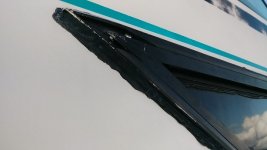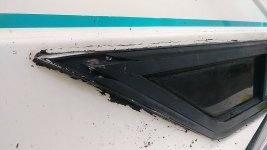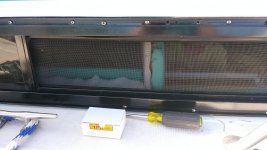PosessionSound26PC
New member
This is my first serious project since buying the boat in 2019. The previous owner informed me that the starboard window, which is something like 11' long and 8" tall, had a leak and water would get in at or find its way down between the bathroom and aft bunk. I confirmed this one fall stormy night before I had purchased a new tarp for the boat - there was a decent pool of water in the small bilge just aft of the bathroom and next to the bunk and it had overflowed and gotten the carpet wet. Also confirmed the port window leaks as I found water in the storage compartment just port of the aft bunk (below the cabin door).
The old windows had been previously caulked w/ some sort of soft black sealant, probably silicone based guessing by its feel and consistency. It was haphazardly gooped on around the top and sides of the window and had visibly failed (no longer adhered to one or both of the substrates) in several locations:

I removed the bulk of the old caulk w/ a plastic scraper to avoid damaging the fiberglass and/or window:


This old caulking was obviously not original, though it's possible the boat did have caulking in that location which was subsequently removed and replaced by this current type. Underneath the caulking, between the aluminum window frame and fiberglass, there appeared to be a foam rubber seal, likely original. At this point my best guess was that this seal was a double-sided adhesive and no bead of sealant was used by Formula. It should be noted that no caulk of any type was visible at the bottom of the window frame as the window is very close to the fiberglass ledge that allows people to walk to the bow of the boat. This last bit seems to confirm that the original design/build did NOT utilize any caulking around the perimeter and that only the foam seal provided water proofing.
I did a bit more research and came across the following authoritative commentary by a well respected marine surveyor who had much to say on this particular type of boat design prevalent in the 80's and 90's (notice the picture of the 27' SeaRay with an almost identical style of cabin window as my 26PC):
https://www.yachtsurvey.com/Windows.htm
At this point, I realized that the article above greatly supports my theory that the leak is at the seal between the window frame and fiberglass hull rather than between the acrylic/plexiglass and the window frame, which was another possibility. The above mainly diagnoses the problem and further commentary, see link below, identifies the fix: replace the old seal with a much more flexible (i.e. larger) one that will allow the upper deck to flex with less chance of breaking the new seal:
https://www.yachtsurvey.com/WindowRepair.htm
I started reading other blogs on boat window re-sealing/re-setting and came across many opinions, but also many testimonials of approaches that had worked. But the key take-away from the surveyor's article, IMO, is that for the style of cabin window on the 26PC, the sealant, whatever it may be, must be very flexible - it cannot be a low elongation or high strength sealant and/or adhesive as this will not allow the deck/window interface to flex without ripping apart again. The article below from BoatUS magazine provides a good summary of the various sealant options, although the article is mainly geared toward bedding of hardware rather than windows with the exception of a paragraph toward the bottom as noted here:
"The alternative for sealing framed windows, if you skip butyl tape, is silicone sealant. Bonded windows require a structural glazing silicone such as Dow 795 (or Sikaflex 295 UV polyurethane protected with a special primer). Beyond portlights and specialized uses, you'll save yourself grief if you keep silicone sealant away from the deck and hull."
https://www.boatus.com/magazine/2013/April/how-to-pick-the-right-sealant.asp
I think the paragraph above mainly applies to the window-frame interface however, not the frame/fiberglass hull as in my case, and I will likely make use of silicone / Dow 795 in re-bedding my cabin hatch lenses (see my blog on that topic) within their aluminum frames. It should be noted that silicone, as noted in their chart, has a relatively low elongation percentage which means it is not really that flexible and therefore not a candidate for my purposes here. In addition, it looks like polyurethanes are not a good option due to low compatibility with plastics and I assume fiberglass/epoxy fits in that category - the exception to this is SikaFlex 295 w/ a primer which we will keep in mind. Butyl tape is also a good option and the article below is a great primer on butyl application (though not tape in this case):
https://www.pbo.co.uk/expert-advice/renovating-boat-windows-27718
Note the use of spacers in re-bedding the window frames in the article above and the mention of spacers in the surveyor's article as well. These are necessary to ensure the bead is large enough to be flexible and to deal with imperfections such as curvature while maintaining a consistent bead width between hull and window frame. I believe Butyl tape and/or paste is probably the ideal candidate from the surveyor's point of view - other than an outer shell, it never cures and remains extremely flexible, though weak - it performs essentially no adherence function between the two substrates. It's a bit messy however and it may be hard to clean up on the underside of my windows which have poor access.
At this point I came to the conclusion that butyl or butyl tape was not really appropriate for my window frame-to-fiberglass hull problem because it was TOO weak. In the last link above, this solution is mainly used for smaller windows where the hull was obviously designed to take the load around the window and not the window itself. In my case, due to the "bad" design mentioned by the surveyor, the window performs a bit like a structural support and I was afraid that the load of someone walking on the deck above the window, as well as while underway, would result in much more deflection/movement and would eventually work the fasteners loose. I decided to stick w/ the original intent of the boat's engineers and look for a double-sided foam tape.
I found a company selling double-sided neoprene rubber seals in the correct width (3/4") and with an acrylic adhesive as recommended for this application by their sales people:
https://presbond.com/
I removed the starboard window, cleaned the old seal and adhesive off w/ a plastic scraper and Goof Off Pro Strength Remover (could not find Krud Kutter Caulk Remover in stock anywhere, including on-line) and repainted the frame w/ Rustomleum 2X Coverage Gloss Black Paint and Primer for a fresh look. Then I applied the new seal and transfer-punched the holes in the frame through the new seal:


The nuts that previously held the fasteners on inside the boat were loose and needed to be held from spinning by a second person on the inside of the boat. I replaced these with serrated flange nuts that I glued onto the inside of the boat to help remove the need for a second person. This mostly worked - a couple came loose and had to be held:

I gave the fiberglass around the window hole a final cleaning by using a nano magic eraser sponge, a final wipe with the Goof Off and one with isopropyl alcohol. I applied 3M AP111 adhesive promoter as suggested to another boat owner by a 3M rep here:
http://sailingcatamarans.com/index.php/faqs/18-building-questions/418-using-tape-to-attach-windows
Then I slowly inserted the window at one end, peeled back the paper cover on the new seal and slowly worked the window in, inserting fasteners as I went and tightening them a little at a time to pull the window in and seat it properly:


The old windows had been previously caulked w/ some sort of soft black sealant, probably silicone based guessing by its feel and consistency. It was haphazardly gooped on around the top and sides of the window and had visibly failed (no longer adhered to one or both of the substrates) in several locations:

I removed the bulk of the old caulk w/ a plastic scraper to avoid damaging the fiberglass and/or window:

This old caulking was obviously not original, though it's possible the boat did have caulking in that location which was subsequently removed and replaced by this current type. Underneath the caulking, between the aluminum window frame and fiberglass, there appeared to be a foam rubber seal, likely original. At this point my best guess was that this seal was a double-sided adhesive and no bead of sealant was used by Formula. It should be noted that no caulk of any type was visible at the bottom of the window frame as the window is very close to the fiberglass ledge that allows people to walk to the bow of the boat. This last bit seems to confirm that the original design/build did NOT utilize any caulking around the perimeter and that only the foam seal provided water proofing.
I did a bit more research and came across the following authoritative commentary by a well respected marine surveyor who had much to say on this particular type of boat design prevalent in the 80's and 90's (notice the picture of the 27' SeaRay with an almost identical style of cabin window as my 26PC):
https://www.yachtsurvey.com/Windows.htm
At this point, I realized that the article above greatly supports my theory that the leak is at the seal between the window frame and fiberglass hull rather than between the acrylic/plexiglass and the window frame, which was another possibility. The above mainly diagnoses the problem and further commentary, see link below, identifies the fix: replace the old seal with a much more flexible (i.e. larger) one that will allow the upper deck to flex with less chance of breaking the new seal:
https://www.yachtsurvey.com/WindowRepair.htm
I started reading other blogs on boat window re-sealing/re-setting and came across many opinions, but also many testimonials of approaches that had worked. But the key take-away from the surveyor's article, IMO, is that for the style of cabin window on the 26PC, the sealant, whatever it may be, must be very flexible - it cannot be a low elongation or high strength sealant and/or adhesive as this will not allow the deck/window interface to flex without ripping apart again. The article below from BoatUS magazine provides a good summary of the various sealant options, although the article is mainly geared toward bedding of hardware rather than windows with the exception of a paragraph toward the bottom as noted here:
"The alternative for sealing framed windows, if you skip butyl tape, is silicone sealant. Bonded windows require a structural glazing silicone such as Dow 795 (or Sikaflex 295 UV polyurethane protected with a special primer). Beyond portlights and specialized uses, you'll save yourself grief if you keep silicone sealant away from the deck and hull."
https://www.boatus.com/magazine/2013/April/how-to-pick-the-right-sealant.asp
I think the paragraph above mainly applies to the window-frame interface however, not the frame/fiberglass hull as in my case, and I will likely make use of silicone / Dow 795 in re-bedding my cabin hatch lenses (see my blog on that topic) within their aluminum frames. It should be noted that silicone, as noted in their chart, has a relatively low elongation percentage which means it is not really that flexible and therefore not a candidate for my purposes here. In addition, it looks like polyurethanes are not a good option due to low compatibility with plastics and I assume fiberglass/epoxy fits in that category - the exception to this is SikaFlex 295 w/ a primer which we will keep in mind. Butyl tape is also a good option and the article below is a great primer on butyl application (though not tape in this case):
https://www.pbo.co.uk/expert-advice/renovating-boat-windows-27718
Note the use of spacers in re-bedding the window frames in the article above and the mention of spacers in the surveyor's article as well. These are necessary to ensure the bead is large enough to be flexible and to deal with imperfections such as curvature while maintaining a consistent bead width between hull and window frame. I believe Butyl tape and/or paste is probably the ideal candidate from the surveyor's point of view - other than an outer shell, it never cures and remains extremely flexible, though weak - it performs essentially no adherence function between the two substrates. It's a bit messy however and it may be hard to clean up on the underside of my windows which have poor access.
At this point I came to the conclusion that butyl or butyl tape was not really appropriate for my window frame-to-fiberglass hull problem because it was TOO weak. In the last link above, this solution is mainly used for smaller windows where the hull was obviously designed to take the load around the window and not the window itself. In my case, due to the "bad" design mentioned by the surveyor, the window performs a bit like a structural support and I was afraid that the load of someone walking on the deck above the window, as well as while underway, would result in much more deflection/movement and would eventually work the fasteners loose. I decided to stick w/ the original intent of the boat's engineers and look for a double-sided foam tape.
I found a company selling double-sided neoprene rubber seals in the correct width (3/4") and with an acrylic adhesive as recommended for this application by their sales people:
https://presbond.com/
I removed the starboard window, cleaned the old seal and adhesive off w/ a plastic scraper and Goof Off Pro Strength Remover (could not find Krud Kutter Caulk Remover in stock anywhere, including on-line) and repainted the frame w/ Rustomleum 2X Coverage Gloss Black Paint and Primer for a fresh look. Then I applied the new seal and transfer-punched the holes in the frame through the new seal:


The nuts that previously held the fasteners on inside the boat were loose and needed to be held from spinning by a second person on the inside of the boat. I replaced these with serrated flange nuts that I glued onto the inside of the boat to help remove the need for a second person. This mostly worked - a couple came loose and had to be held:

I gave the fiberglass around the window hole a final cleaning by using a nano magic eraser sponge, a final wipe with the Goof Off and one with isopropyl alcohol. I applied 3M AP111 adhesive promoter as suggested to another boat owner by a 3M rep here:
http://sailingcatamarans.com/index.php/faqs/18-building-questions/418-using-tape-to-attach-windows
Then I slowly inserted the window at one end, peeled back the paper cover on the new seal and slowly worked the window in, inserting fasteners as I went and tightening them a little at a time to pull the window in and seat it properly:



